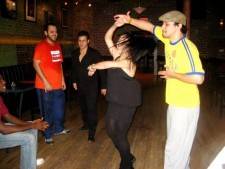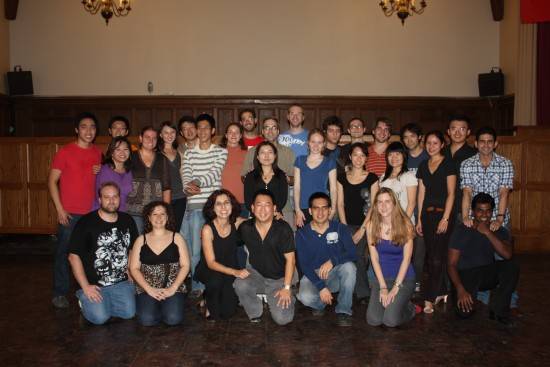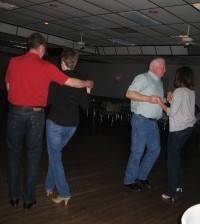When it comes to salsa dancing, a man must train six times as long as a woman to be at the same approximate skill level – at least, that’s what CUATSALSA dance teacher Mügé Dizén tells people.
Dizén explained that salsa, a dance with clear lead and follow roles, allows women to be somewhat intellectually passive on the dance floor; women are responsible only for responding to movement cues given to them by their partners, and it is for this reason that it is much easier for women to improve their skills than it is for their male counterparts. Men are challenged to build and master an arsenal of dance moves, and then to learn to communicate sequences of movement with their partners – without using words.
To further complicate the process, salsa dancers, or “salseros,” seldom dance with the same partner all night. The act of switching partners forces both leads and follows to constantly readjust, compensating for differences in height, salsa experience and movement vocabularies, in addition to adapting to overall variances in chemistry with new partners. This process increases the sociability of the salsa community by encouraging mixing among groups; it also keeps salseros constantly engaged and learning.
There are two different ways to learn to salsa, explained salsa dancer and deejay Bris Mueller Garcés; one can learn to dance culturally or formally.
Mueller explained that cultural dancers such as him learn to dance salsa by simply doing it – by immersing themselves in Latin culture and allowing repeated experiences to familiarize their bodies with Latin dance movement vocabulary. For those dancers, downtown Champaign is the place to be; Radio Maria, Highdive and Cowboy Monkey each provide a weekly opportunity for community members to hone and build on their Latin dance skills – though some are more instruction-friendly than others.
Salsa dancer and deejay Juan Miguel Atkinson explained that he teaches at downtown Champaign bar Highdive on Friday nights from 8-10:30 p.m.
“It is a very early, very informal thing,” he said. “There is no cover and the sound system is available. You can even drag your own song onto the playlist.”
Atkinson explained that Friday night at Highdive is hip-hop night, but noted that the hip-hop crowd does not usually arrive until about 11 p.m.
“The manager [of Highdive] is a friend of Bris’ and mine, so we kind of fill the space during those early hours as a favor to him,” he said. “He gave us the first few hours to do our thing. We really do it just to encourage people to dance – to make the salsa community grow.”
 Atkinson and Mueller created two groups – the “Basics” and the “Not-so-Basics” – that meet on alternate Fridays at Highdive. The aptly named “Basics” group covers salsa basics, while the “Not-so-Basics” group focuses more on learning choreography.
Atkinson and Mueller created two groups – the “Basics” and the “Not-so-Basics” – that meet on alternate Fridays at Highdive. The aptly named “Basics” group covers salsa basics, while the “Not-so-Basics” group focuses more on learning choreography.
“For the Not-so-Basic group, the idea is that someone new will teach choreography each week. People will volunteer and teach technique or something they saw on Youtube,” Atkinson said. “We don’t discriminate based on the level of the person teaching…I will be there to help the teacher get his or her message across; I will fill in the holes.”
The goal is that each dancer will eventually get a chance to share something with the group.
“There is a very limited number of people that is sharing knowledge about salsa dancing right now,” Atkinson explained. “Everybody is passively taking in information, and then they all hit a plateau; no one is moving forward.”
Atkinson added that while not all salseros like the same moves or styles, a much richer learning environment is perpetuated by a group that is constantly exchanging knowledge.
When Mueller started salsa dancing in 1994, salsa dance classes in C-U were primarily taught in the Colombian style, he explained. One teacher – a man named Mark – taught New York style, or “slot” salsa dancing. But his work didn’t have much impact, Mueller said.
“Mark’s students didn’t come out dancing …and he was white,” Mueller said. “If you have an extremely exotic-looking Colombian guy – he had long hair and he was a beautiful dancer – and a white guy, and they are both trying to present dance to you from Latin America, one of them seems much more authentic. They were both right, but Mark couldn’t prove that his style was valid.”
It was not until Puerto Rican students who had learned to dance New York style salsa in Chicago and New York came to the UIUC, Mueller explained, that the style caught on in C-U.
“They started teaching each other how to dance and they started a performance group called Orgullo Latino Americano (OLA)…and then they started to teach people to dance for free,” Mueller said. “They had an advantage in teaching people who were young, because they were undergrads and they were Latino.”
But not all C-U salseros can thrive in a campus environment.
For those salsa dancers who prefer a more structured form of Latin dance instruction, CUATSALSA and the Regent Ballroom offer professional lessons year-round; each venue has three different levels to accommodate for varying student experience, but the class schedule changes based on community demand. Beginner classes, for example, are always offered; Intermediate and Advanced class offerings vary based on the skill level of those enrolled.
Yuri Sohn, salsa teacher for CUATSALSA, explained that the organization offers six sessions each year; fall, spring and summer are each bisected into two five-week blocks. On average, about 70 people enroll in the Fall I beginner class, while Fall II and summer beginner classes see an average of about 30. Intermediate classes range from 23-34 people; Advanced classes range from 19-31 on average.

“Our Beginner class enrollment has more of a range,” Dizén explained. “Summer is lower numbers because there are fewer students around. Spring and Fall get bigger numbers at the beginning of each semester.”
At the Regent Ballroom, attendance at the 11-week Latin classes range from 15-30 couples; there, the winter session and the 6-week summer session tend to be the most popular, said Latin dance teacher Sandra Hendrix-Lopez. The demographic at the Regent is slightly older than the largely UIUC student-based population at CUATSALSA, with most students in their upper 30s and early 40s.
“We also get a lot of our ballroom students who are older who want to try the Latin styles,” Hendrix-Lopez explained.
Aware of the venue’s older demographic, the Regent Ballroom staff holds public dances every Friday to allow their students opportunities to practice their skills and to interact socially outside of class. But Latin dance nights have not always been a staple on the Regent’s public dance calendar.
“We are just recently starting to do the public Latin dances again; this is only the second Latin dance we have had in a long time,” Hendrix-Lopez explained. “We used to have salsa dances every Friday from 11-2 a.m. when salsa was very popular a few years ago, but it got too crazy – there were too many people and too many fights.”
Recognizing that most of the Regent’s students “are not the type who would go to Cowboy Monkey or Radio Maria,” the staff decided to give Latin dance night a second chance.
“We wanted to make a nice space for [our students] to practice,” Hendrix-Lopez said. “I deejay, and I monitor the speed of songs.”
Hendrix-Lopez explained that for people who are trying to learn to salsa dance, dancing at 180 beats per minute (b.p.m.), which is the average salsa tempo, can be overwhelming. The Regent’s Latin classes begin dancing to songs with a tempo of 150 b.p.m. and gradually move up; at the public dances, Hendrix-Lopez said that she plays songs with 160 and 170 b.p.m. tempos.
“At those speeds, the students can still practice and feel like they had some success during the night,” she said.
Champaign resident and Regent Ballroom student Nancy Mansfield echoed Hendrix-Lopez’s statements.
“Latin dancing has a faster beat, so that can be a challenge,” Mansfield said. “As far as learning Latin goes, it is fairly easy to learn…but if you don’t practice it, you lose it.”
Mansfield and her husband attended the Regent Ballroom’s public Latin dance on April 2, 2011; the pair started taking ballroom dancing lessons at the Regent four or five years ago, Mansfield explained, and has progressed from ballroom to West Coast swing to Latin.
Mansfield said that she likes the Latin dance music the Regent plays in class, and noted that Latin dancing is a skill that couples can use frequently.
“A lot of nightclubs play Latin music,” Mansfield said. “And if you go on a cruise, that is the kind of music you will hear. It is just fun.”
Mansfield added that Latin dancing is a fun thing to do with couples, and that she and her husband have made many friends at the Regent Ballroom.
Louise and Gilbert Reyes, a middle-aged couple from Bloomington-Normal, said they have also made friends through Latin dancing.
Though the couple does not take class at the Regent, they said that they prefer it to the campus bar scene.
“We usually come out to the Regent when they have Latin dances…We have danced at Radio Maria as well, but it is totally different there,” Louise said. “Personally I prefer it here… There are more beginners, like us, on campus, but it is also more wild and chaotic. Since we are a married couple, [the Regent] is more for us.”
 Gilbert noted that couples “can play around with the dance floor” more at the Regent; Louise agreed that there is much more space in the Regent Ballroom.
Gilbert noted that couples “can play around with the dance floor” more at the Regent; Louise agreed that there is much more space in the Regent Ballroom.
“And you would see better dancers here [in comparison to at Radio Maria],” Louise said.
The Mansfields also regularly attend the Regent Ballroom’s public dances, Nancy said, but they have not ventured onto the campus salsa scene.
“We haven’t attended any of the salsa nights in the Champaign bars – but it is mostly because of intimidation,” she said. “We just finished Latin 2 [class at the Regent], so maybe we will make it to the Champaign bars this summer.”
According to Mueller, salsa dance instruction is something that is key to keeping the Champaign-Urbana salsa nightlife thriving; he also stressed that salsa is not something that can be learned purely in a social context.
“There is a give and take in social salsa dancing that is hard to trick people into – when you are out salsa dancing, you want to dance…and you want to dance with the best person in the room,” he explained. “So, the better dancers get better because they are dancing with each other…but that doesn’t create any new, better dancers.”
Mueller noted that there are not many people who salsa at an intermediate level, and that it can be hard to bridge the gap between advanced dancers and beginners in a social context – but that doesn’t stop people from trying.
Atkinson echoed Mueller’s observations, and explained that he sees equal parts of people who take lessons and people who learn on the spot in C-U’s salsa community.
“A lot of people have scheduling problems, so they can’t make it to class but they come out to dance and are enthusiastic,” Atkinson said. “The classes are something that is in high demand. A lot of people want to get the right mechanics…They don’t want to feel foolish dancing with someone who is a better dancer.”
Mueller explained that when it comes to learning to dance socially, women are at an advantage; Dizén agreed.
“I think guys have trouble learning to lead [without formal instruction],” she said. “The followers – the ladies – pick it up easier. They don’t have to plan and execute, they just execute.”
UIUC Department of Dance Alumna Kim McCarthy offered some cultural insight about the situation.
“I think as Americans we don’t really grow up with salsa in our houses, so women are often going out to dance and meeting a guy who is Latino,” she said. “I used to hang out with a group of Peruvian guys who would help my American guy friends figure out how to dance…For guys, it was easier to figure it out if they took class.”
Fellow UIUC Department of Dance Alumna Lesley Werle recognized her advantage as a female in the salsa community.
“It was a lot easier for me to learn, having the traditional role of being the follow. I can’t lead to save my life,” she said. “But if I have a good lead, I can just jump in and dance all night long.”
Dizén said that the lead-follow relationship is her favorite thing about salsa dancing.
“For me, what is most fun about dancing is that I don’t have to think, and I like that. Putting my mind at ease is a blessing,” she said. “I don’t have to worry about anything. I just need to enjoy. I inhale the moment.”
Dizén’s colleague Yuri Sohn said that for him, the best thing about dancing salsa is the physical and mental high it produces.
“If you have good communication and interaction with your partner, dancing is a very addictive feeling…It gets the endorphins going,” he said. “If you have a bad day, you can go dancing and feel better – but I think that is true about any kind of dancing.”
Sohn noted that salsa dancing is also a great form of exercise.
“I would much rather dance salsa than go running on a treadmill,” he said. “With salsa, you can exercise, listen to good music and socialize…you may not always be successfully communicating with a partner, but you always try.”
Sohn explained that sometimes, salseros can have no connection with one another.
“A person can be a great dancer but you just somehow don’t work together as a couple – maybe the person is looking at [himself or herself] in the mirror or you are just an appendage on [his or her] arm – that is challenging,” he said. “But you can just finish that dance and move on.”
And that’s easy to do in a city with such a hopping salsa nightlife.








